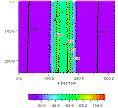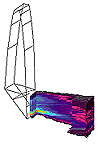Optical Design, Fabrication and Testing At TIG
TIG designs innovative light handling systems, builds prototypes and tests their performance using detailed comparisons with computer simulations. The process of design typically starts with image-based characterization of the light source. The spatial and angular distributions of the radiance of the source are characterized using digitized images and image processing software. This allows designs of optical elements that take the near field details of the source into account, leading to greater efficiency.
An example is this radiance map of a tubular neon lamp with a mirrored aperture mask aligned along the tube axis.
 |
 |
Click on the thumbnail to
see full size image. |
Generally we create our designs, which are usually nonimaging optics, in solids modeling CAD programs. These can be immediately transferred to a solids-based optical simulation program such as TracePro® by Lambda Research. When the simulations show that we are getting the desired results, the solid model is sent to a specialized machine shop and a rapid prototype is created. The prototype can then be subjected to detailed comparison with predictions of the computer simulations using a variety of image-based photometric techniques developed by TIG.
 |
Click on the thumbnail to
see full size image. |
An example of image based photometry is the three dimensional mapping of the light flux emerging from a prismatic collimator shown in this picture:
The local flux density is designated by the color of the object next to the wireframe model of the optic. A segment of the flux density object has been cut away to reveal the inner structure of the flux distribution.
© 2000 Technology Integration Group
|